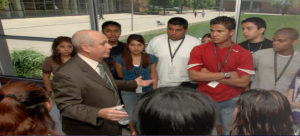Downtown business at risk

Dan McMichaels stands outside his restaurant in the Biergarten that is another part of his business. The Biergarten is at risk of being lost forever
Roth Lovins
Staff Writer, 5 Rights News
On a typical evening at the Rathskeller Biergarten, there is a cornucopia of people singing and dancing along to the live performer of the night, enjoying the present company and, of course, the beer. The overall atmosphere is one of relaxation and friendliness because of the staffers who work there. Amidst the crowd, trying to enjoy the music while not drawing attention to himself sits Dan McMichaels, the owner of Rathskeller and its corresponding Biergarten.
McMichaels has been the owner of the restaurant and Biergarten since 1995. Since the start of his business, he has had to rent out the space for his companies from the Athenaeum Turners. For the most part, the deal was beneficial to both of the parties involved. That is, until the Athenaeum Turners sent some unsettling news to McMichaels.
“Two days after the 2012 Super Bowl, I received a letter from the landowners of the building,” McMichaels said. “In the letter, they asked to audit the records as a part of our leasing agreement.”
McMichaels cooperated and made sure that all demands were met in accordance with their agreement. Not long after that, McMichaels received yet another letter.
“The next letter told us that we weren’t able to use the Rathskeller name on our advertising and merchandising products throughout the restaurant,” McMichaels said.
McMichaels was upset and took actions with his attorney. After some time in court and mediation, the situation seemed to be appeased, but that was only the beginning of it all.
“The next cease and detest that we got was one that told us that we had to shut down the live entertainment,” McMichaels said. “They basically told us that starting July 1, we had to close the Biergarten for good.”
For McMichaels, the Biergarten was the backbone for his company and was upset over losing the world-renowned creation.
“The landowners felt that they weren’t getting enough money from me, so they decided to cut off the source of all my money in efforts to get me to ‘roll over’ for them, but I’m not going to,” McMichaels said.
On top of that, McMichaels said that the foundation itself was struggling and wouldn’t be able to help out the rest of the community if they lost their main source of income.
“We have offered our space to non-for profit organizations and helped raise money for local organizations in efforts to give back to the community and without the Biergarten, it will be harder for us to support them,” McMichaels said.
One of the projects that the Rathskeller Biergarten took on was the ‘America Remembers 9/11’ in efforts to raise money for the local Fire Department Bereavement Fund.
“We were able to donate $160,000 to the organization thanks to all the support and funds that came from the Biergarten and its patrons,” McMichaels said.
Along with his contributions through organizations, McMichaels is able to help specific people in the community through a variety of ways.
“In the past, I bought an apartment building and made repairs to it so that the neighborhood wouldn’t suffer because of it,” McMichaels said. “ I have also donated free food services to volunteers who work on some of the construction projects downtown.”
McMichaels hope is that all the people who he has met through his business will be willing to band together and help join his campaign.
“People can join the ‘Save the Biergarten’ campaign and try and campaign against the Athenaeum Foundation so we can keep all the fun going,” McMichaels said. “I know the support will be there because of the traditions that are present in the community.”
For more information on how you can join the ‘Save the Biergarten’ campaign and other ways you can get involved, check out the Rathskeller website and their Facebook page at www.rathskeller.com.









